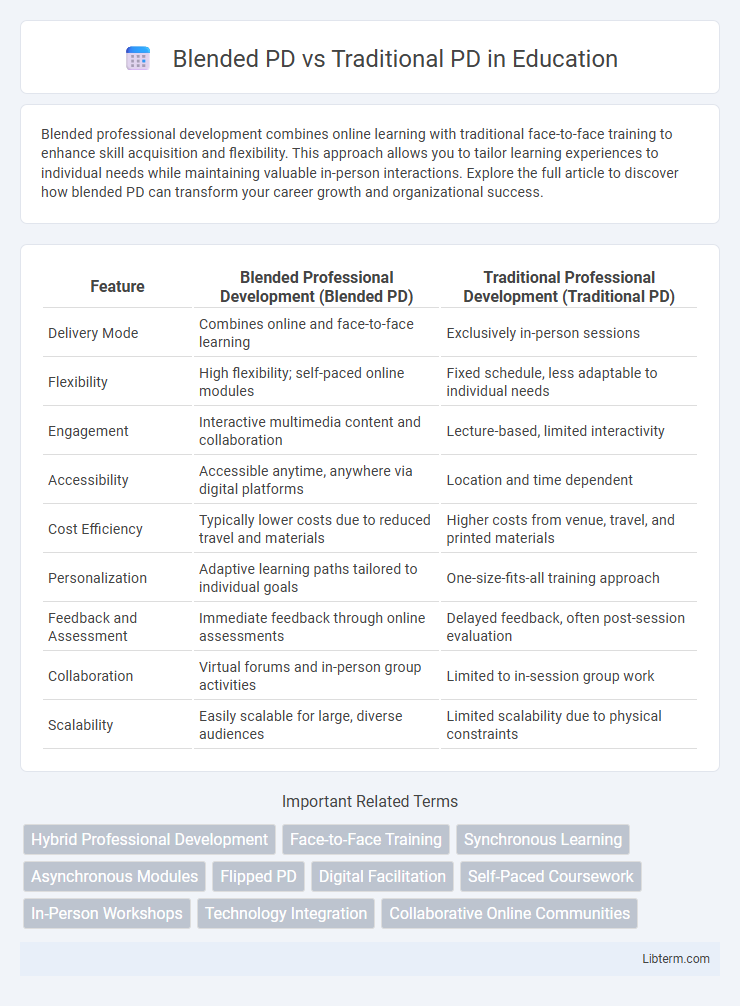Blended professional development combines online learning with traditional face-to-face training to enhance skill acquisition and flexibility. This approach allows you to tailor learning experiences to individual needs while maintaining valuable in-person interactions. Explore the full article to discover how blended PD can transform your career growth and organizational success.
Table of Comparison
| Feature | Blended Professional Development (Blended PD) | Traditional Professional Development (Traditional PD) |
|---|---|---|
| Delivery Mode | Combines online and face-to-face learning | Exclusively in-person sessions |
| Flexibility | High flexibility; self-paced online modules | Fixed schedule, less adaptable to individual needs |
| Engagement | Interactive multimedia content and collaboration | Lecture-based, limited interactivity |
| Accessibility | Accessible anytime, anywhere via digital platforms | Location and time dependent |
| Cost Efficiency | Typically lower costs due to reduced travel and materials | Higher costs from venue, travel, and printed materials |
| Personalization | Adaptive learning paths tailored to individual goals | One-size-fits-all training approach |
| Feedback and Assessment | Immediate feedback through online assessments | Delayed feedback, often post-session evaluation |
| Collaboration | Virtual forums and in-person group activities | Limited to in-session group work |
| Scalability | Easily scalable for large, diverse audiences | Limited scalability due to physical constraints |
Introduction to Professional Development Models
Blended professional development (PD) combines online digital media with traditional face-to-face learning, enhancing flexibility and accessibility for educators. Traditional PD typically involves in-person workshops and seminars focused on direct interaction but may lack personalized pacing and immediate resource availability. Integrating technology through blended PD models optimizes engagement and allows for continuous, individualized learning aligned with modern educational demands.
Defining Traditional Professional Development
Traditional Professional Development (PD) typically involves in-person workshops, seminars, or conferences where educators engage in passive learning through lectures and presentations. This model emphasizes standardized training sessions delivered at set times and locations, often lacking customization for individual teacher needs or ongoing support. Traditional PD frequently faces challenges such as limited interactivity and minimal opportunities for practical application or follow-up.
What is Blended Professional Development?
Blended Professional Development (PD) combines online digital media with traditional face-to-face training, allowing educators to access flexible, interactive learning experiences while maintaining personal engagement. This model integrates synchronous and asynchronous learning methods, enhancing collaboration and personalized feedback compared to conventional PD formats. Research shows blended PD increases knowledge retention and skill application by leveraging technology to support continuous, adaptive learning tailored to individual educator needs.
Key Differences: Blended vs. Traditional PD
Blended Professional Development (PD) combines online digital media with traditional face-to-face instruction, offering flexible learning schedules and personalized learning paths, unlike Traditional PD which relies solely on in-person sessions. Blended PD enhances learner engagement through interactive multimedia and real-time feedback, while Traditional PD often follows a fixed curriculum with limited interactivity. Key differences include accessibility, adaptability, and the integration of technology, which make Blended PD more scalable and effective in meeting diverse professional learning needs.
Benefits of Blended Professional Development
Blended professional development combines online digital media with traditional face-to-face methods, offering flexibility and personalized learning experiences that traditional PD lacks. This approach increases engagement through interactive content and allows educators to access resources anytime, enhancing knowledge retention and skill application. Studies show blended PD leads to higher teacher satisfaction and improved student outcomes compared to solely traditional models.
Limitations of Traditional PD Approaches
Traditional professional development (PD) approaches often suffer from limited customization and passive learning formats that reduce engagement and retention. Time constraints and one-size-fits-all sessions hinder educators' ability to apply new skills effectively in diverse classroom settings. This leads to lower impact on teaching practices compared to more flexible, interactive blended PD models that integrate online and face-to-face learning.
Impact on Educator Engagement and Learning Outcomes
Blended professional development (PD) integrates online and face-to-face learning modalities, resulting in higher educator engagement compared to traditional PD models that rely solely on in-person sessions. Research indicates that educators participating in blended PD demonstrate improved learning outcomes, including enhanced instructional strategies and increased student achievement. The flexible, interactive nature of blended PD supports sustained teacher motivation, deeper content mastery, and practical application in diverse classroom settings.
Cost-Effectiveness and Accessibility Comparison
Blended professional development (PD) significantly reduces costs by combining online modules with in-person sessions, minimizing expenses related to travel, venue rental, and printed materials compared to traditional PD. Its accessibility improves as educators can engage in training anytime and anywhere, accommodating diverse schedules and reducing geographic barriers. Traditional PD often requires fixed times and locations, limiting participation and increasing overall program costs.
Best Practices for Implementing Blended PD
Blended Professional Development (PD) combines online learning flexibility with face-to-face interaction, enhancing engagement and personalized learning paths compared to traditional PD models. Best practices for implementing blended PD include leveraging data analytics to tailor content, incorporating interactive multimedia, and scheduling regular synchronous sessions to foster collaboration and reflection. Effective blended PD also emphasizes continuous feedback loops and aligns training objectives with teachers' classroom needs to maximize impact and retention.
Future Trends in Professional Development Models
Blended professional development (PD) integrates online digital learning with traditional face-to-face instruction, enhancing flexibility and accessibility compared to conventional PD models that rely solely on in-person sessions. Emerging trends emphasize personalized PD pathways powered by artificial intelligence, enabling educators to tailor learning experiences to individual needs and optimize skill acquisition. Future models will likely leverage data analytics and virtual collaboration tools to foster continuous, adaptive professional growth, surpassing the limitations of traditional one-size-fits-all PD formats.
Blended PD Infographic

 libterm.com
libterm.com